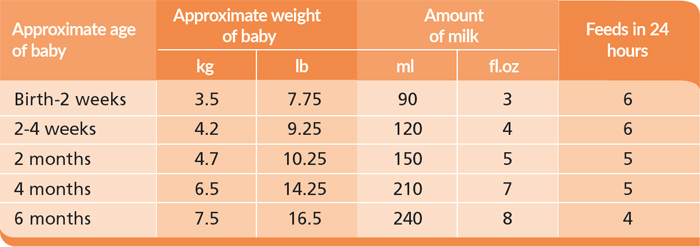0-6 months

Bottle feeding
In 0-6 months
Bookmark
Record learning outcomes
If a parent chooses to bottle feed their baby with infant formula milk, there is plenty of advice that the pharmacy team can provideÂ

Appetite
Babies are not all the same and appetites will vary even among those of the same weight or age. A baby’s appetite will also vary from day to day and week to week. Advise parents to let their babies be the guide as to how hungry they are by looking out for these signs:
- When the baby has had enough, they will fall asleep or let go of the teat
- If a baby doesn’t want to finish a feed, don’t force them
- If they are still awake and interested in the bottle when the feed is finished, they probably need larger feeds.
 Top tips for bottle feeding
Top tips for bottle feeding
- Feed the baby in a calm, relaxed atmosphere that is at a comfortable temperature
- Hold the baby fairly upright with his/her head supported so that he/she can breathe and swallow easily and comfortably
- Make eye contact, chat and smile at the baby during a feed as this makes it more enjoyable for the baby and encourages successful bonding
- Keep the teat full of milk at all times so that the baby is not taking in air
- As with breastfeeding, swap sides halfway through the feed. This helps the baby’s eyes and neck to develop equally and also means that they won’t develop a ‘favourite’ side
- If the baby becomes unsettled during a feed then they may have wind
- For mums who have had a caesarean, holding their babies under their arms or in a ‘rugby ball’ hold can be more comfortable. A pillow across the lap can also help to support the baby
- Don’t lay the baby flat on his/her back as this can allow milk to flow into the nose or Eustachian tube, leading to ear infections. Babies should also not be fed while propped up in a chair with cushions or pillows.
Example on-pack feeding guide*
Each infant formula milk comes with guidelines on how much to give based on the age/weight of the baby. The following table provides a general guide, but it should be noted that it does NOT apply to premature babies or babies with a low birthweight.

N.B. This table is only a guide – babies may need more or less than the amounts stated and should be fed on demand. Newborn babies may only take small amounts of infant formula to start with.
*Powder weights vary by brand, so always check the instructions on-pack.
Winding after feeding
Some babies are not troubled by wind, while others suffer after every feed. The aim of winding babies is to remove air from their stomachs because air can make them uncomfortable and stop them settling. Babies can swallow air when they drink, especially from a bottle, and when they cry. In general, babies need to be winded halfway through a feed and when they have finished.
There are two main positions for winding:
- Lying the baby over a shoulder
- Sitting the baby on a lap, holding the back and chin.
The baby’s back should be rubbed or patted until they bring up their wind – often with a satisfying burp! Some babies bring up a little milk or ‘posset’ during winding, so it can be useful to have a cloth or muslin square handy.
Weaning
Weaning is the process of moving babies on from only drinking milk to including solid foods in their diet. The Department of Health recommends that babies should be weaned at around six months of age.
Advise parents that many babies have a growth spurt at around four months, which can make them hungrier than usual.
It’s important not to confuse this with the real signs of weaning because an infant’s digestive system needs time to develop before solids are introduced. In such cases, babies may benefit from an infant formula milk for hungrier babies that contains more casein protein. This may take longer to digest, which can help hungrier babies feel more satisfied.
Further details on weaning can be found in the weaning section.
N.B. If parents are thinking about choosing a different infant formula milk for their baby, they should discuss it with a healthcare professional, such as the pharmacist or pharmacy technician, first.
  Is baby ready for weaning?
 Is baby ready for weaning?
Signs to look out for that indicate a baby may be ready for weaning include:
- Staying in a sitting position, holding their head steadyÂ
- Co-ordinating their eyes, hands and mouth so that they can look at food, pick it up and put it in their mouth by themselvesÂ
- Swallowing food. Babies who are not ready will push their food back out.
Â
Next, read the article on feeding problems.
